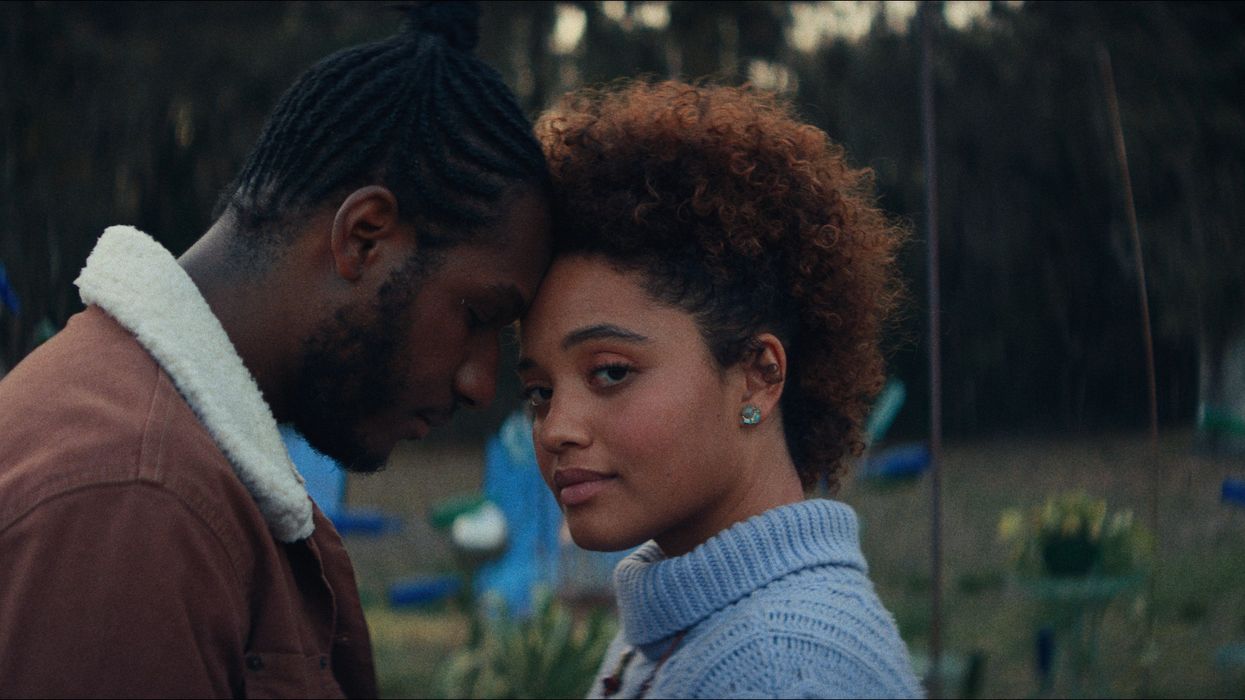How Did the Production and Costume Designers of the SXSW Movie ‘The Young Wife’ Conceptualize the Future?
Your best work may be done via collaboration.

In the world of filmmaking, collaboration, and creative vision go hand in hand to bring captivating stories to life. Such is the case with the upcoming film The Young Wife, directed by Tayarisha Poe and production designed by Rocío Giménez and costume designed by Laura Cristina Ortiz. In an exclusive interview, Giménez and Ortiz share their inspiration, approach to the creative process, and memorable moments during the production of this visually stunning project.
Check it out below.
Editor's Note: This interview has been edited for length and clarity.
NFS: What Inspired you to do this project?
Laura Cristina Ortiz: When I first received Tayarisha Poe's lookbook and script, it was a creative surprise. Her lookbook was bursting with vivid, bold, and surrealist photography and fashion–very much unlike what you imagine a wedding film pitch would look like. The first page of the script detailed that movement within the film would be more like choreography, as this story was from a very subjective, emotional point of view. I was immediately and simultaneously curious and excited. The script was so whimsical I fell head over heels for the story and visuals. The moment I finished reading it I knew I had to design this very special project.
Rocío Giménez:After reading the first page of the script, I knew this project was going to be very special to make, and I was excited about the possibility of collaborating with Tayarisha. In the script’s first page, Tayarisha describes the environment, the time period, and the characters, defining the rules of the world in which The Young Wife takes place. She also defines the rules of the storytelling of the film, giving notes on Celestina’s unique perception, the visual discontinuities, and also notes on movement and general tone. This approach of defining the parameters that encompass all the elements of the story aligns with my own design philosophy, which involves thinking within a uniquely crafted box tailored to each project. I knew that collaborating with Tayarisha, Jomo, and Laura on this true world-building process was going to be a deeply inspiring experience.
NFS: How did you approach the creative process to this project?
LCO: The world of Celestina, River, and their friends and families is visually rich and chaotic, so collaboration was integral to developing the creative. Tayarisha, Jomo, Rocio, and I had several creative calls prior to official pre-production so we could develop the aesthetic across all of our depts. From understanding the zeitgeist of the world Tayarisha wrote to developing unique idioms like "acid expressionism," "harmonious dissonance of anxiety," and "post-apocalyptic maximalism," we worked very closely to hone in design motifs and themes. Tayarisha wanted contrasting textile diversity–natural driftwood next to iridescent holographic acrylic, and cotton next to recycled plastic. This is a fictional world in our near future–supply chains worsen and are unable to produce new plastic, for example, so what was the zeitgeist? What are the counter and subcultures in this society? We wanted to give a dopamine rush to the audience, aesthetically, by filling them with magic and wonder.
RG: My approach to the design process began with defining the core concepts that would govern the film. From there, I dived from outside in, carefully sculpting the spaces along with their objects, the motifs, the color palettes, and the materials in accordance with the rules outlined in Tayarisha’s script. Our starting point was to imagine a time period set roughly 10 years from the present day. We poured ourselves into extensive research of what this future could look like. In our conceptualized future, the impact of climate change had put an end to automation and limited the production of plastic, resulting in characters who had to rely on outdated electronics from the past. We also had to consider the future of “office” and coworking spaces, as in the film, Celestina quits her job.
The world of The Young Wife is an ode to future nostalgia, fusing together the aesthetics of the '60s space-era with the vibrant hues of the '80s, while incorporating electronics from the '90s and early 2000s, plus a variety of contrasting materials and shapes.
One of my favorite themes we explored in The Young Wife was the idea of nature reclaiming its space. In one scene, River's family brings an abundance of flower bouquets to the house, adding vibrant color to an otherwise dark environment dominated by the brown tones of driftwood. To create the impression of an overwhelming floral invasion that would effectively obscure the furniture and surroundings, my decorator, Samita Wolfe, and I searched for light and transparent furnishings. As a result, we decided to decorate one of the main rooms in the house using only lucite furniture. This approach allowed us to achieve the desired effect of making the furniture appear and disappear under the flower bouquets.
NFS: Can you discuss any particularly memorable moments during the production of this project?
RG: Arriving at the filming location in Darien, Georgia was a highly memorable moment for me. The main house where the non-wedding scenes take place is situated off the intercoastal waterway and is predominantly constructed of driftwood. This unique location provided the ideal setting for us to achieve the contrasting visuals and the sense of isolation we were aiming for. The house stands out among the surrounding landscape, appearing as though it's the last structure left in the world. This creates a sense of fragility, making the location feel all the more isolated and surreal.

 'Anora'Neon
'Anora'Neon Annie Johnson Kevin Scanlon
Annie Johnson Kevin Scanlon









